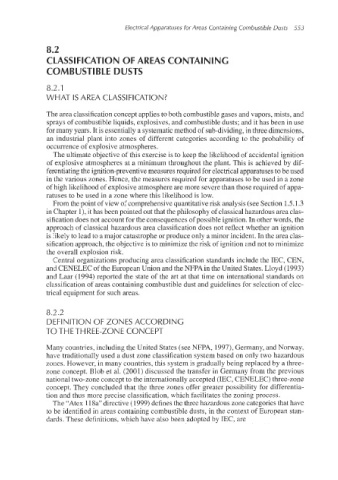Page 586 - Dust Explosions in the Process Industries
P. 586
ElectricalApparatuses for Areas Containing Combustible Dusts 553
ASSIFICATION OF AREAS CONTAINING
COMBUSTI BLE DUSTS
8.2.1
WHAT IS AREA CLASSIFICATION?
The area classification concept applies to both combustible gases and vapors, mists, and
sprays of combustible liquids, explosives, and combustible dusts; and it has been in use
for many years. It is essentially a systematic method of sub-dividing, in three dimensions,
an industrial plant into zones of different categories according to the probability of
occurrence of explosive atmospheres.
The ultimate objective of this exercise is to keep the likelihood of accidental ignition
of explosive atmospheres at a minimum throughout the plant. This is achieved by dif-
ferentiating the ignition-preventivemeasures required for electrical apparatuses to be used
in the various zones. Hence, the measures required for apparatuses to be used in a zone
of high likelihood of explosive atmosphere are more severe than those required of appa-
ratuses to be used in a zone where this likelihood is low.
From the point of view of comprehensive quantitative risk analysis (see Section 1.5.I .3
in Chapter I), it has been pointed out that the philosophy of classical hazardous area clas-
sification does not account for the consequences of possible ignition. In other words, the
approach of classical hazardous area classification does not reflect whether an ignition
is likely to lead to a major catastrophe or produce only a minor incident. In the area clas-
sification approach, the objective is to minimize the risk of ignition and not to minimize
the overall explosion risk.
Central organizations producing area classification standards include the IEC, CEN,
and CENELEC of the European Union and the NFPA in the United States. Lloyd (1993)
and Laar (1994) reported the state of the art at that time on international standards on
classification of areas containing combustible dust and guidelines for selection of elec-
trical equipment for such areas.
8.2.2
DEFlhllTlON OF ZONES ACCORDING
TO THE THREE-ZONE CONCEPT
Many countries, including the United States (see NFPA, 19971,Germany, and Norway,
have traditionally used a dust zone classification system based on only two hazardous
zones. However, in many countries, this system is gradually being replaced by a three-
zone concept. Blob et al. (2001) discussed the transfer in Germany from the previous
national two-zone concept to the internationally accepted (IEC, CENELEC) three-zone
concept. They concluded that the three zones offer greater possibility for differentia-
tion md thus more precise classification, which facilitates the zoning process.
The “Atex 1l8a” directive (1999) defines the three hazardous zone categories that have
to be identified in areas containing combustible dusts, in the context of European stan-
dards. These definitions, which have also been adopted by IEC, are

